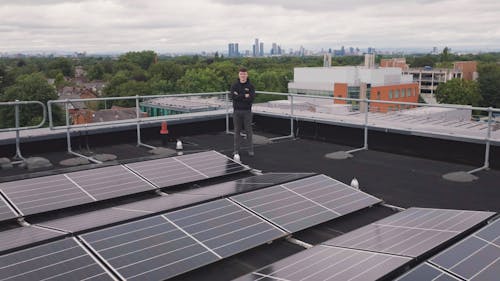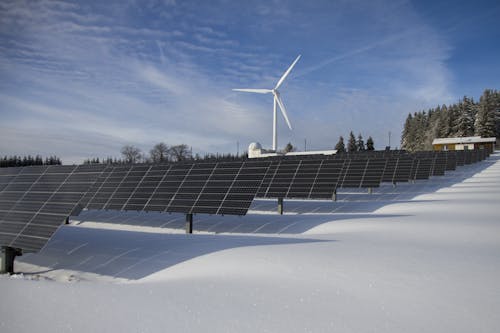
Introduction
In the face of escalating environmental challenges, the pursuit of sustainable technology has become a critical component of global efforts to mitigate climate change and reduce environmental impact. Sustainable technology encompasses innovations and practices that aim to minimize resource consumption, reduce emissions, and promote the responsible use of materials. This essay explores how green innovations in technology are reshaping industries, enhancing environmental sustainability, and paving the way for a greener future.
The Need for Sustainable Technology
1. Environmental Challenges
The rapid industrialization and technological advancements of the past century have led to significant environmental degradation. Key issues include:
- Climate Change: Rising greenhouse gas emissions are driving global temperature increases, leading to extreme weather events and rising sea levels.
- Resource Depletion: Overexploitation of natural resources such as fossil fuels, minerals, and water is causing resource shortages and environmental damage.
- Pollution: Industrial processes, transportation, and waste contribute to air, water, and soil pollution, adversely affecting ecosystems and human health.
2. The Role of Technology in Addressing Environmental Issues
Technology has both contributed to environmental challenges and holds the potential to address them. Sustainable technology seeks to harness innovation to create solutions that minimize negative environmental impacts while promoting economic and social benefits.
Key Goals of Sustainable Technology:
- Resource Efficiency: Reducing the consumption of resources through innovative designs and processes.
- Emission Reduction: Lowering greenhouse gas emissions and other pollutants.
- Waste Management: Improving recycling, reuse, and waste reduction practices.
Green Innovations in Sustainable Technology
1. Renewable Energy Technologies
Renewable energy technologies are at the forefront of sustainable innovations, providing clean alternatives to fossil fuels and reducing greenhouse gas emissions.
Types of Renewable Energy Technologies:
- Solar Power: Solar photovoltaic (PV) panels convert sunlight into electricity, offering a clean and abundant energy source. Innovations in solar technology include improved efficiency, flexible panels, and integration with building materials.
- Wind Power: Wind turbines harness wind energy to generate electricity. Advancements include larger and more efficient turbines, offshore wind farms, and innovations in turbine design.
- Hydropower: Hydropower generates electricity from the kinetic energy of flowing water. Sustainable practices include small-scale hydro projects and the use of run-of-river systems to minimize environmental impact.
- Geothermal Energy: Geothermal systems use heat from the Earth’s core to generate electricity and provide heating. Innovations include enhanced geothermal systems (EGS) and improved drilling techniques.
Benefits of Renewable Energy Technologies:
- Reduced Emissions: Renewable energy sources produce little to no greenhouse gas emissions.
- Sustainable Resource Use: Unlike fossil fuels, renewable energy sources are replenished naturally and are less likely to deplete resources.
- Energy Independence: Renewable energy can reduce reliance on imported fossil fuels and enhance energy security.
2. Energy-Efficient Technologies
Energy-efficient technologies aim to reduce energy consumption while maintaining or improving performance. Innovations in this area include:
Examples of Energy-Efficient Technologies:
- LED Lighting: Light-emitting diodes (LEDs) are highly energy-efficient compared to traditional incandescent bulbs, offering longer lifespans and lower energy consumption.
- Smart Grids: Smart grid technology uses digital communication to monitor and manage energy distribution, improving efficiency and reducing energy waste.
- Energy-Efficient Appliances: Modern appliances, such as refrigerators, washing machines, and HVAC systems, are designed to consume less energy and operate more efficiently.
Benefits of Energy-Efficient Technologies:
- Reduced Energy Consumption: Energy-efficient technologies lower the amount of energy needed for various applications, leading to cost savings and reduced environmental impact.
- Lower Operating Costs: Reduced energy consumption translates to lower utility bills and operating expenses.
- Extended Equipment Lifespan: Many energy-efficient technologies are designed to last longer and require less maintenance.
3. Green Building Technologies
Green building technologies focus on designing and constructing buildings that minimize environmental impact and improve energy efficiency.
Key Green Building Innovations:
- Sustainable Materials: The use of eco-friendly building materials, such as recycled or renewable resources, reduces environmental impact and supports sustainable construction practices.
- Energy-Efficient Design: Building designs that incorporate passive solar heating, natural ventilation, and high-performance insulation reduce energy consumption and enhance comfort.
- Green Roofs and Walls: Green roofs and living walls provide insulation, reduce heat island effects, and improve air quality while promoting biodiversity.
Benefits of Green Building Technologies:
- Reduced Environmental Impact: Green buildings minimize resource use, reduce emissions, and lower waste generation.
- Improved Indoor Air Quality: Sustainable materials and design practices contribute to healthier indoor environments.
- Enhanced Energy Efficiency: Green buildings use less energy for heating, cooling, and lighting, resulting in cost savings and reduced carbon footprints.
4. Circular Economy and Waste Management
The circular economy is a model that emphasizes the reuse, recycling, and repurposing of materials to minimize waste and resource consumption. Sustainable technology plays a key role in advancing this model.
Examples of Circular Economy Innovations:
- Recycling Technologies: Advanced recycling technologies, such as chemical recycling and waste-to-energy systems, convert waste materials into valuable resources and energy.
- Product Design for Longevity: Designing products with durability, repairability, and recyclability in mind reduces waste and extends product lifecycles.
- Resource Recovery: Technologies for recovering valuable materials from electronic waste and other sources support sustainable resource management.
Benefits of Circular Economy and Waste Management:
- Reduced Waste: Efficient recycling and resource recovery practices minimize the amount of waste sent to landfills.
- Resource Conservation: Reusing and recycling materials reduce the need for virgin resources and lower environmental impact.
- Economic Opportunities: The circular economy creates new business models and opportunities for innovation in waste management and resource recovery.
Case Studies in Sustainable Technology
1. Tesla’s Electric Vehicles
Tesla Inc. is a pioneer in the electric vehicle (EV) market, driving the adoption of sustainable transportation solutions. Tesla’s electric cars, including the Model S, Model 3, and Model X, offer zero-emission alternatives to traditional gasoline-powered vehicles.
Key Innovations:
- Advanced Battery Technology: Tesla’s development of high-capacity lithium-ion batteries improves vehicle range and performance.
- Autonomous Driving: Tesla’s Autopilot system incorporates AI and sensor technology to enhance driving safety and efficiency.
Impact on Sustainability:
- Reduced Emissions: Tesla’s EVs contribute to lower greenhouse gas emissions compared to conventional vehicles.
- Energy Efficiency: Tesla’s vehicles are designed to be highly efficient, maximizing energy use and minimizing waste.
2. IKEA’s Sustainable Furniture Initiatives
IKEA is a leader in sustainable furniture design and production, focusing on eco-friendly materials and circular economy principles.
Key Innovations:
- Sustainable Materials: IKEA uses renewable and recycled materials, such as bamboo, recycled plastics, and sustainably sourced wood.
- Product Recycling: The company promotes recycling and reuse of its furniture through take-back programs and modular designs.
Impact on Sustainability:
- Resource Efficiency: IKEA’s use of sustainable materials reduces environmental impact and supports responsible resource management.
- Waste Reduction: The company’s recycling initiatives minimize waste and promote circular economy practices.
Challenges and Future Directions
1. Technological and Economic Barriers
While sustainable technology offers significant benefits, challenges remain in widespread adoption and implementation.
Key Challenges:
- High Initial Costs: The upfront cost of implementing sustainable technologies can be prohibitive for some businesses and consumers.
- Technological Limitations: Some green technologies are still in the development phase and may face technical and performance limitations.
Future Directions:
- Cost Reduction: Continued research and innovation are expected to lower costs and improve the accessibility of sustainable technologies.
- Policy Support: Government policies and incentives can encourage the adoption of green technologies and support research and development efforts.
2. Integration and Scalability
Integrating sustainable technologies into existing systems and scaling up their use are critical for maximizing their impact.
Key Considerations:
- System Integration: Ensuring that new technologies integrate seamlessly with existing infrastructure and workflows is essential.
- Scalability: Developing solutions that can be scaled to meet global demand and address diverse environmental challenges.
Future Directions:
- Collaborative Approaches: Collaboration between technology developers, policymakers, and industry stakeholders can facilitate integration and scalability.
- Global Adoption: Expanding the use of sustainable technologies worldwide can enhance their effectiveness and impact.

Conclusion
Sustainable technology is a key driver of environmental progress, offering innovative solutions to reduce the environmental impact of human activities. Through advancements in renewable energy, energy efficiency, green building, and circular economy practices, green innovations are transforming industries and contributing to a more sustainable future. While challenges remain, ongoing research, policy support, and collaboration will continue to advance these technologies and maximize their benefits. By embracing sustainable technology, we can address environmental challenges, promote economic growth, and build a healthier planet for future generations.











